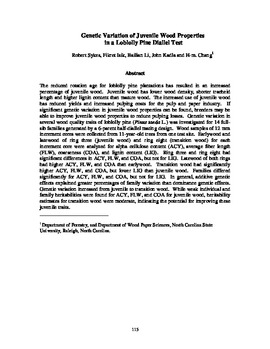| dc.contributor.author | Sykes, R. | |
| dc.contributor.author | Isik, F. | |
| dc.contributor.author | Li, B. | |
| dc.contributor.author | Kadla, J. | |
| dc.contributor.author | Chang, H. | |
| dc.date.accessioned | 2016-04-25T19:36:01Z | |
| dc.date.available | 2016-04-25T19:36:01Z | |
| dc.date.issued | 2003 | |
| dc.identifier | oksd_sf27_p115.pdf | |
| dc.identifier.citation | Sykes, R., Isik, F., Li, B., Kadla, J., & Chang, H. (2003). "Genetic Variation of Juvenile Wood Properties in a Loblolly Pine Diallel Test." In 27th Southern Forest Tree Improvement Conference, Stillwater, OK | |
| dc.identifier.uri | https://hdl.handle.net/11244/33676 | |
| dc.description.abstract | The reduced rotation age for loblolly pine plantations has resulted in an increased percentage of juvenile wood. Juvenile wood has lower wood density, shorter tracheid length and higher lignin content than mature wood. The increased use of juvenile wood has reduced yields and increased pulping costs for the pulp and paper industry. If significant genetic variation in juvenile wood properties can be found, breeders may be able to improve juvenile wood properties to reduce pulping losses. Genetic variation in several wood quality traits of loblolly pine (Pinus taeda L.) was investigated for 14 full-sib families generated by a 6-parent half-diallel mating design. Wood samples of 12 mm increment cores were collected from 11-year-old trees from one test site. Earlywood and latewood of ring three (juvenile wood) and ring eight (transition wood) for each increment core were analyzed for alpha cellulose content (ACY), average fiber length (FLW), coarseness (COA), and lignin content (LIG). Ring three and ring eight had significant differences in ACY, FLW, and COA, but not for LIG. Latewood of both rings had higher ACY, FLW, and COA than earlywood. Transition wood had significantly higher ACY, FLW, and COA, but lower LIG than juvenile wood. Families differed significantly for ACY, FLW, and COA, but not for LIG. In general, additive genetic effects explained greater percentages of family variation than dominance genetic effects. Genetic variation increased from juvenile to transition wood. While weak individual and family heritabilities were found for ACY, FLW, and COA for juvenile wood, heritability estimates for transition wood were moderate, indicating the potential for improving these juvenile traits. | |
| dc.format | application/pdf | |
| dc.language | en_US | |
| dc.relation.ispartofseries | Sponsored publication . . . of the Southern Forest Tree Improvement Committee ; no. 49 | |
| dc.rights | This paper is made available through open access and the auspices of the fair use doctrine for scholarly, educational and research purposes while recognizing the publisher already offers a free online version. The OSU Library�s intent is to offer access and preserve publications involving its faculty contributions. Contact the Digital Resources and Discovery Services at lib-dls@okstate.edu or 405-744-9161 for the permission policy on the use, reproduction or distribution of this material. | |
| dc.source | Proceedings of the 27th Southern Forest Tree Improvement Conference, volume 27, 2003. Editor, Craig R. McKinley. | |
| dc.title | Genetic Variation of Juvenile Wood Properties in a Loblolly Pine Diallel Test | |
| dc.type | text | |
| osu.filename | oksd_sf27_p115.pdf | |
| dc.type.genre | Conference proceedings | |
| dc.description.scopeandcontents | Papers and abstracts from the 27th Southern Forest Tree Improvement Conference held at Oklahoma State University in Stillwater, Oklahoma on June 24-27, 2003. | |
